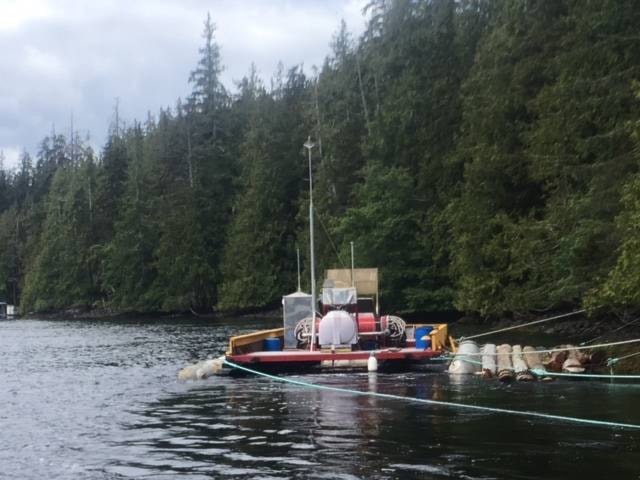The tide is turning for what may be Haida Gwaii’s energy future.
On June 19, the big slow paddles on a tidal-powered water pump made their first turns in Juskatla Narrows.
Invented by islander Laird Bateham, the small-scale prototype was built together with fellow Haida Gwaiians Alden Bateham, Dan Abbott, Geoff Hyatt, and Clyde Greenough.
If built to full scale with a hilltop water reservoir on the nearby Begbie Peninsula, the pump could one day push water through a closed loop of pipes so it spins a turbine and gets Haida Gwaii off diesel-fired electricity.
Unlike other tidal-power systems, including a reservoir will allow it to provide power even at slack tide.
“It’s quiet,” Greenough said.
“The paddles are all you hear.”
Speaking to the Observer from Queen Charlotte on Monday, Laird and Clyde’s phone call also went quiet — cut off by a surprise power outage.
“Another reason for this thing to happen!” said Greenough, laughing.
After holding an open house in Port Clements last spring, the homegrown Haida Gwaii company — Yourbrook Energy Systems — had hoped to tow their barge-mounted prototype to Juskatla in a month or so.
But the barge that holds the paddle wheel, pump, pipes, and electronic controls was floating too low for comfort, so they took the time to add more buoyancy.
“We’re just easing into it,” said Laird Bateham, noting that a key part of the first testing phase is to see how durable the system is, especially the pump seals.
“Everything’s working good,” he said. “There are a few things we need to tweak — that’s to be expected.”
Two weeks ago, Haida Gwaii had some of its biggest tides of the year, which drew a number of drift logs through the narrows. The prototype handled them easily, Bateham said.
For now, the prototype is only spinning on the outgoing tide, and it’s resting against the shore rather than in the strongest currents in the middle of Juskatla Narrows.
Incredibly as it may seem to everyone in cell-less Port Clements, the barge actually gets an Internet connection over the cellular network, so the team will soon be able to monitor the water pressure, flow rates, and other data from Geoff Hyatt’s office in Queen Charlotte.
Asked how long they will gather data in the first test, Bateham said they hope to finish by fall. The findings should let them know just how much bigger a full-scale system would need to be.
Apart from a $280,000 grant from the National Research Council of Canada, the rest of the $600,000 prototype is largely self-funded.
Greenough said Yourbrook is consulting with the Council of the Haida Nation on future testing, and they have had calls from several government agencies about funding. The City of Prince Rupert has also spoken with the company about the possibility of installing a similar system on the Galloway, Butze, or Zanardi Rapids.
